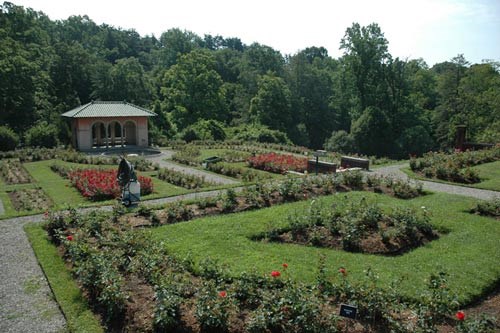
NPS
At Vanderbilt Mansion National Historic Site in Hyde Park, New York, roses that had been lost in the formal garden were replanted with multiple rose species and varieties that reflected the historic colors and forms of the original 1916 planting, designed by Robert Cridland for the Vanderbilts. This rehabilitation approach increased the genetic diversity of the planting, thereby enhancing pest and disease resistance.
In addition, replanting a diverse collection of roses allowed for flexibility in collaborating with the park’s friends group, which contributed to the installation of plant material; the replanting decision also supported the NPS’s current in-house maintenance capacity. In addition to the environmental benefits of a genetically diverse replacement planting, these other two dimensions of the project were central to fulfilling the social and economic aspects of sustaining the garden in perpetuity.5
On the National Mall, a cultural landscape in Washington, DC, over two hundred American elm (Ulmus americana) trees have succumbed to Dutch elm disease since 1952. Dutch elm disease is caused by three strains of a micro-fungus, Ophiostoma ulmi, and is spread by the European elm bark beetle (Scolytus multistriatus) and the native elm bark beetle (Hylurgopinus rufipes). On the Mall, the NPS has replaced the American elm trees lost to the disease with a range of different elm species, including many Dutch elm disease- tolerant cultivars of the American elm.6 The genetic diversity afforded by this planting of multiple species and multiple cultivars—including Ulmus americana ‘‘Jefferson,’’ ‘‘Washington,’’ ‘‘Princeton,’’ and ‘‘Liberty’’—helps to build the capacity of the Mall’s trees to withstand mutations in the disease or the introduction of new diseases or pests.

NPS
The Jefferson elm is a triploid, meaning that its cells contain three sets of each chromosome. All other American elms are tetraploid, with four sets of each chromosome. This natural mutation was advantageous and allowed the specimen to tolerate Dutch elm disease. The NPS and United States Department of Agriculture studied this specimen closely, propagated it, and released the new cultivar to the nursery trade in 2005. Along with other Dutch elm disease-tolerant cultivars, it has been replanted on the National Mall many times. The original Jefferson elm still stands.7
Diversity reduces the effects of disturbances by allowing for different responses to a given stress. Diversity can be created by design through rehabilitation or, in the case of biotic features, by providence through conscientious maintenance and monitoring. As the spread of woody plant pests and diseases accelerates with climate change, both natural and designed environments increasingly benefit from genetic diversity. This diversity may be overt, as in the form of multiple species, or more subtle, through multicultivar or multivariety plantings.

NPS
As demonstrated by the Jefferson elm, attempting to maintain some specimens in spite of disease or pests also presents the possibility that diversity will occur naturally. Great Smoky Mountains National Park has been significantly impacted by American chestnut blight, the pathogenic fungus Cryphonectria parasitica.
In Towson, Maryland, Hampton National Historic Site is anticipating significant impacts due to a small green beetle called emerald ash borer (Agrilus planipennis). In addition to planning for diverse replacement plantings, the NPS has been working to preserve select populations of host trees with the hope of identifying individual specimens with natural resistance.5. John W. Hammond, Margie Coffin Brown, and Brona Keenan, Cultural Landscape Report for the Vanderbilt Mansion Formal Gardens (Boston, Mass.: National Park Service, Olmsted Center for Landscape Preservation, 2011).
6. The first elm tree in Washington, DC, infected with Dutch elm disease was found near the Lincoln Memorial in 1946.
7. Jonathan Pliska, National Mall Jefferson Elm, Historic American Landscapes Survey No. DC-7 (Washington, DC: National Park Service, 2006); James L. Sherald, Elms of the Monument Core: History and Management Plan (Washington, DC: National Park Service National Capital Region, Center for Urban Ecology, 2009 draft).
Last updated: February 24, 2017
